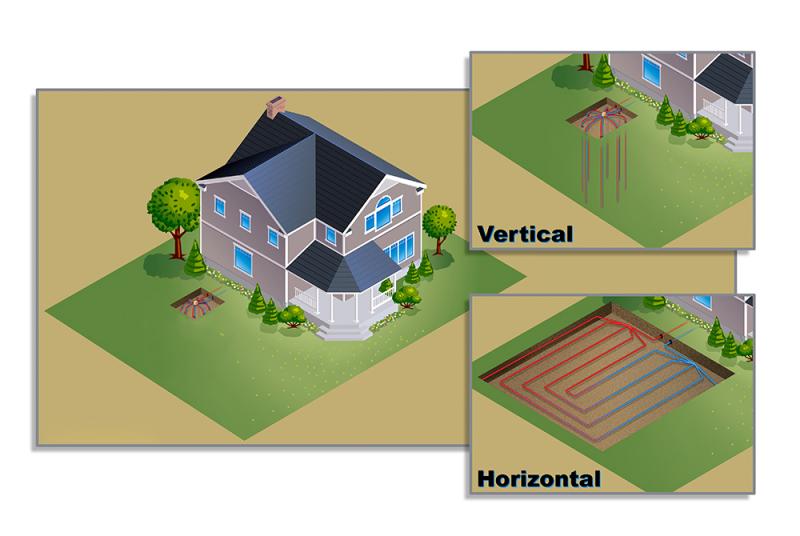How Geothermal Works

Geothermal heating and cooling is the process of extracting heat energy from the ground and using it to control room temperatures and heat water.
This is done by a process of heat exchange;
- A fluid is pumped through a series of underground pipes (a ground loop), as the fluid passes through the pipes it is heated.
- A heat pump takes low-grade heat from the ground loop and warms refrigerant through a process of heat transfer, the refrigerant starts as a liquid and then evaporates.
- Once the refrigerant has evaporated; it is heated further using a compressor, the hot gaseous refrigerant is then passed through a heat exchanger where it heats the water and air for your house.
This process is possible because below-ground temperatures remain relatively stable (10-15°C), even when outdoor temperatures can vary substantially throughout the days and seasons. The heat capacity of the ground relative to the ambient air is much greater. This affords Ground Source Heat Pump systems much higher annual efficiencies than Air Source systems.
Ground loops
A ground loop can be either closed-loop (recirculating the same fluid) or open-loop (takes water from a groundwater source or lake and returns it after it’s passed through the heat exchanger). Closed loops systems are generally used the most for both residential dwellings and commercial buildings. There are three types that you need to consider, horizontal loops, vertical loops, and lake loop.
Vertical loops are used when there’s limited ground space available, they can be open-loop if there is a suitable water source but are usually closed loop. A pair of pipes connected with a u-bend is inserted into a borehole that is typically drilled between 50-400 ft deep. The void between the pipes and the ground is filled with a grout such as a bentonite or a Cementous mixture to improve heat transfer and to seal the borehole. Bentonite improves heat transfer between the ground and loop because it has higher thermal conductivity than air. Vertical ground loops are more expensive to install but require much less pipework to achieve the same results as horizontal loops because underground temperatures are higher and more stable the deeper you go.
Horizontal loops are most often used in new properties or rural properties with greater available land area. The loop is typically buried in trenches that are 1-2 meters deep and cover a large area, no specialized drilling equipment is required. The excavated material is used to refill the trench after the loop has been installed. Because there is no grout, typically the system will perform better where the soil is wet year-round. To meet the same efficiency as vertical systems, the piping system has a greater length.
Lake loop systems are similar to horizontal ground loops but are used when the building is close to a large body of water. The system can be an open or closed loop. The loop has to be deep enough to provide adequate heat (approximately 8ft or deeper).
Coefficient of Performance (CoP)
CoP is a measure of how efficient a system is; a more efficient system uses less energy. Geothermal heating and cooling systems are the only systems that have a CoP above 1. This is because the energy supplied by the ground loop doesn’t cost anything. A system with a higher CoP is more efficient and will cost less to run in the long term. CoP is a ratio so is unitless, the formula is simple:
CoP = Energy Out / Energy In
(The unit of energy is Watts)
Distribution systems – Forced Air / Hydronic
Once the heat has been generated, it needs to be distributed around the home; there are two options, forced air distribution or hydronic distribution.
A forced-air system provides hot/cool air to different rooms in the building through a network of ducting and vents. The air is pushed through a heat exchanger in the heat pump using a highly efficient blower fan. The air is then pushed through the building to different rooms. Forced air systems are less efficient but less expensive to install. The distribution of particles and allergens throughout the home by moving air is a major disadvantage, this can worsen conditions such as Asthma. However, filtration systems can be applied. Having a ductwork system in place makes the cooling operation relatively simple compared to systems without ductwork.
The hydronic heating system takes heated water from the heat pump and distributes it through a closed network of pipes. Common methods for heating a room are underfloor heating and radiators. Hydronic systems are more efficient and more comfortable than forced air systems but they are more expensive to install.
MORE ARTICLES
HEPA Filtration District Heating - Yes, we can. What is the RHI and what can Canada learn Specifying Evaporative Cooling Equipment: A Quick Reference








